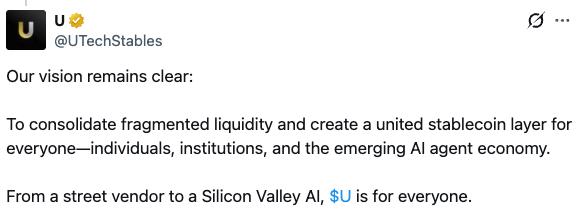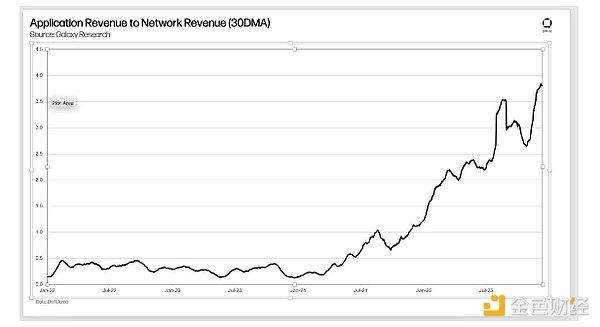Editor's note: Stablecoins, if large enough, could pose a threat to the U.S. economy because they would reduce the money supply in the banking system and weaken the Federal Reserve's ability to implement monetary policy. However, stablecoins promote dollar dominance globally, improve cross-border payment efficiency, and help non-U.S. residents obtain stablecoins. When the supply of stablecoins reaches trillions of dollars, stablecoin issuers like Circle could become part of the U.S. economy, and regulators would need to balance monetary policy with the needs of programmable money.
The following is the original content (for easier reading and understanding, the original content has been reorganized):
Addison (@0xaddi) and I have recently been discussing the huge interest in the integration of TradFi and cryptocurrencies and their core real-world use cases. Here is a summary of our conversation around the U.S. financial system and how cryptocurrencies fit into it from a “first principles” perspective:
The current mainstream narrative is that tokenization will solve many financial problems — which may or may not be true.
The issuance of stablecoins creates new money supply, just like banks do. The current trajectory of stablecoins raises an important question: how do they interface with the traditional fractional reserve banking system, in which banks keep only a portion of deposits as reserves and lend the rest, effectively creating new money supply?
Tokenization has become a market trend
The current narrative is "tokenizing all assets" - from public market stocks to private equity to government bonds - which is good for cryptocurrencies and the global financial system. But if we want to think about the changes happening in the market from "first principles", we need to clarify the following questions:
How does the existing asset ownership system work?
How will tokenization change the system?
Why is tokenization necessary?
What is a real “dollar” and how is new money created?
Currently in the United States, large asset issuers (such as listed company stocks) will give custody of their ownership certificates to DTCC (Depository Trust & Clearing Corporation). DTCC is responsible for tracking ownership records for approximately 6,000 accounts that interact with it, and these accounts further manage the asset ledgers of their end users. For private companies, the model is slightly different, and companies such as Carta are mainly responsible for the equity ledger management of enterprises.
Both models rely on highly centralized ledger management. The DTCC model is similar to a "Matryoshka" structure, where individual investors may need to go through 1 to 4 different intermediaries before they finally touch the actual ledger entries of the DTCC. These institutions may include the brokerage or bank where the investor opens an account, the brokerage's custodian or clearing company, and the DTCC itself. Although ordinary retail investors are not directly affected by this hierarchical system, it adds a lot of due diligence work and legal risks for institutions.
If the DTCC were able to natively tokenize assets directly, reliance on these intermediaries would be reduced as market participants could interact more directly with the clearinghouse — but this is not the solution currently being proposed in mainstream discussions.
The current tokenization model typically involves an entity holding the underlying asset as a record on its main ledger (such as a sub-entry on DTCC or Carta), and then creating a new tokenized version on-chain for trading. This model is inherently inefficient because it introduces additional intermediaries, resulting in value extraction, increased counterparty risk, and settlement and clearing delays. In addition, adding an intermediary undermines composability because an additional "packing and unpacking" step is required when assets circulate between traditional finance and decentralized finance, which can further delay transactions.
A better solution might be to make all assets “natively tokenized” and put the DTCC or Carta ledger directly on-chain so that all asset holders can enjoy the benefits of on-chain programmability.
One of the main reasons for tokenizing stocks is to enable global market access and provide 24/7 trading and settlement. If tokenization can be a bridge for stocks to enter emerging markets, it will indeed be a leap forward in the existing system, allowing billions of people around the world to access US capital markets. However, it is still unclear whether tokenization on the blockchain is necessary, as the issue is essentially more about regulation than technical limitations.
Similar to the regulatory arbitrage of stablecoins, whether asset tokenization can become an effective regulatory arbitrage method on a long enough time scale remains to be explored. Similarly, a common bullish view on on-chain stocks is its potential for integration with perpetual contracts, but the main obstacle currently hindering the development of stock perpetual contracts is entirely regulatory issues, not technical issues.
Stablecoins (i.e. tokenized dollars) are similar in structure to tokenized stocks, but the stock market is more complex, involving a whole set of clearing houses, exchanges, and brokers, and is strictly regulated. Unlike "normal" crypto assets (such as BTC), tokenized stocks are not native tokenized assets, but are backed by real-world assets and are less composable.
To build an efficient on-chain market, the entire traditional financial system needs to be replicated, which is an extremely complex and nearly impossible task due to the concentration of liquidity and the influence of existing network effects. Simply tokenizing stocks and putting them on-chain will not solve all problems, because ensuring that these assets are liquid and compatible with the traditional financial system requires a lot of infrastructure construction and thoughtful design.
However, if Congress passes a law that allows companies to issue digital securities directly on-chain without going public through an IPO, many traditional financial institutions will no longer be necessary (and this possibility may be reflected in the new market structure bill). Tokenized stocks can also reduce the compliance costs of companies going public.
Currently, governments in emerging markets have little incentive to legalize access to U.S. capital markets, as they prefer to keep capital within their economies. From a U.S. perspective, liberalizing access would raise anti-money laundering (AML) issues.
Additional note: To some extent, the variable interest entity (VIE) structure adopted by Alibaba ($BABA) in the U.S. stock market is already a form of "tokenization." American investors do not directly hold Alibaba's original shares, but rather hold shares in a Cayman company and enjoy Alibaba's economic rights through contracts. Although this approach does expand market access, it also creates new entities and new equity structures, greatly increasing the complexity of assets.
The Real Dollar & the Federal Reserve
Real dollars are entries on the Fed’s books. Currently, about 4,500 entities (banks, credit unions, some government agencies, etc.) can access these “real dollars” through the Fed’s master account. No native crypto institution can directly access these funds, unless you count Lead Bank and Column Bank, which provide services to some crypto companies such as Bridge.
Institutions with master accounts can use Fedwire, a payment network with almost zero cost and near-instant settlement, which runs 23 hours a day and can basically achieve instant settlement. The real US dollar belongs to M0 (the sum of all balances on the Federal Reserve's books), while the "pseudo-dollar" is M1 created by commercial banks through loans, which is about 6 times the size of M0.
From a user experience perspective, using real dollars is actually pretty good - the transfer cost is only about 50 cents, and settlement is instant. Whenever you wire funds from your bank account, your bank does it through Fedwire, which has almost zero downtime, instant settlement, and very low latency. However, due to compliance risks, anti-money laundering requirements, and fraud detection, banks set many restrictions on large payments, which leads to friction on the user side.
The Bear Case for Stablecoins
From this structure, the potential risk facing stablecoins is that if "real dollars" can be more widely obtained without the need for intermediaries, the core role of stablecoins will be weakened. Currently, stablecoin issuers rely on bank partners, and these banks have master accounts at the Federal Reserve. For example:
USDC enters the Federal Reserve system through JPMorgan Chase and Bank of New York Mellon;
USDT is connected to the U.S. banking system through financial institutions such as Cantor Fitzgerald.
So, why don’t stablecoin issuers directly apply for the Federal Reserve’s main account?
After all, it’s a cheat code that allows them to:
Directly obtain 100% risk-free government bond returns without the need to deposit reserves through a bank intermediary as is currently the case;
Solve liquidity issues and achieve faster settlement.
Stablecoin issuers’ requests for Fed master accounts are likely to be rejected, just as The Narrow Bank’s application was rejected. In addition, crypto banks like Custodia have also been unable to obtain master accounts. However, Circle may have a close enough relationship with its partner banks that its liquidity will not be greatly affected even without a master account.
The reason why the Federal Reserve will not approve the application for the main account of the stablecoin issuer is that the US dollar system relies on the fractional reserve banking system-the entire economic system is built on the basis that banks hold only a small amount of reserves.
Banks create new money through debt and loans, and if anyone can earn a 90% or 100% interest rate return risk-free (without having to lend money to mortgages, businesses, etc.), then who would want to use traditional banks? If no one saves, banks can't make loans, create money, and the economy will stagnate.
The Federal Reserve considers two core principles when evaluating master account eligibility:
Cannot introduce excessive cybersecurity risks;
Cannot interfere with the Federal Reserve’s monetary policy implementation.
For these reasons, it is almost impossible for current stablecoin issuers to obtain master accounts.
The only possible scenario is that stablecoin issuers "become" banks (but they may not be willing to do so). The GENIUS Act proposes bank-like regulation for stablecoin issuers with a market value of more than $10 billion. In other words, if stablecoin issuers eventually have to accept bank-level regulation, they may become more like a bank in the long run. But even so, due to the 1:1 reserve requirement, they still cannot engage in fractional reserve banking-like operations.
Stablecoins have not been killed by regulation so far, largely because most stablecoins (like Tether) are based overseas. The Fed’s global dominance of the dollar is perpetuated in this way — even if not through fractional reserve banking — because it helps solidify the dollar’s reserve currency status. However, if a large institution like Circle (or even a narrow bank) were widely used for deposit accounts in the U.S., the Fed and Treasury might be concerned because it would move money out of the banks that run the fractional reserve model, which are key to the Fed’s monetary policy.
This is essentially the same problem that stablecoin banks face: to make loans, you need a banking license. But if the stablecoin is not backed by “real dollars”, it is no longer a stablecoin and loses its meaning. This is exactly the “breaking” point of the fractional reserve model. However, in theory, a stablecoin issued by a licensed bank holding a master account can operate under the fractional reserve model.
Banks vs. Private Lending vs. Stablecoins
The only benefit of being a bank is access to a master account at the Federal Reserve and FDIC insurance. These two privileges allow banks to assure depositors that their deposits are "real dollars" (backed by the US government), even though they have actually been loaned out.
However, one does not need to be a bank to make loans (private credit companies often do this). The difference between banks and private credit is that the "deposit certificates" provided by banks are treated as actual dollars and are interchangeable with deposit certificates of other banks. Therefore, although the bank's assets are completely illiquid (locked up by loans), these deposit certificates are still completely liquid. This mechanism of converting deposits into illiquid assets (loans) while maintaining the perception of the value of deposits is the core of money creation.
In the private credit system, the value of the deposit certificate is based on the value of the underlying loan assets. Therefore, private credit does not create new money, and you cannot really use the deposit certificate of private credit for payment.
Using Aave as an analogy for how banks and private credit work in the crypto world:
Private credit: In the current system, you can deposit USDC into Aave and receive aUSDC. aUSDC is not always 100% backed by USDC, as part of the deposit has been loaned to users as collateral. Just like merchants will not accept private credit certificates, you cannot pay directly with aUSDC.
However, if economic participants are willing to accept aUSDC exactly as they would USDC, then Aave is functionally equivalent to a bank, with aUSDC being the “dollars” that the bank promises to depositors, while all of the backing asset (USDC) is loaned out.
A simple example: Addison provides $1,000 of tokenized private credit to the Bridget Credit Fund, which can be spent like dollars. Bridget then lends the $1,000 to someone else, and there is $2,000 of value in the system ($1,000 loan + $1,000 tokenized Bridget Fund). In this case, the $1,000 loaned is just debt, essentially a bond, a claim on the $1,000 that Bridget loaned.
Stablecoins: Are they creating “net new money”?
If the above logic is applied to stablecoins, then stablecoins do functionally create “net new money”. Further explanation:
Suppose you buy a U.S. Treasury bond for $100. You now own a Treasury bond, but it cannot be used directly as money. You can only sell it at the market price. In the background, the U.S. government is actually spending the $100 (because it is essentially a loan).
Let’s say you deposit $100 into Circle, and Circle uses that money to buy Treasury bonds. The government is still spending the $100 — but you’re also spending the $100 because you received 100 USDC and can spend it anywhere.
In the first case, you just hold a Treasury bond and cannot use it directly. In the second case, Circle creates a "mapping" of the Treasury bond that allows it to be used like a dollar.
In terms of money issuance per dollar deposited, the impact of stablecoins is limited because most stablecoins have their reserve assets in short-term Treasury bills, which are less affected by interest rate fluctuations. In contrast, banks issue much more money than stablecoins because they have longer-term liabilities and their loans are riskier. When you redeem a Treasury bond, the government pays you by selling another Treasury bond - and the cycle continues.
Ironically, despite the fact that cryptocurrencies are rooted in cypherpunk values, every time a new stablecoin is issued, it actually just makes it cheaper for governments to borrow and fuels inflation (because the increased demand for government bonds essentially supports government spending).
If stablecoins become large enough (e.g. Circle takes up 30% of M2 supply — currently stablecoins only account for 1% of M2), they could pose a threat to the U.S. economy. This is because every dollar that flows from the banking system into stablecoins is a net reduction in the money supply (because banks “create” more money than stablecoin issuance creates), and regulating the money supply has historically been the exclusive domain of the Federal Reserve. Stablecoins would also undermine the Fed’s ability to implement monetary policy through the fractional reserve banking system.
Nevertheless, the advantages of stablecoins on a global scale are unquestionable: they expand the influence of the US dollar, strengthen the US dollar's position as a reserve currency, improve the efficiency of cross-border payments, and greatly help non-US residents who need stable currencies.
When stablecoin supply reaches trillions of dollars, stablecoin issuers like Circle may become deeply integrated into the U.S. economy, and regulators will have to find a way to balance monetary policy needs with programmable money.
「 Original link 」
Welcome to join the BlockBeats official community:
Telegram subscription group: https://t.me/theblockbeats
Telegram group: https://t.me/BlockBeats_App
Official Twitter account: https://twitter.com/BlockBeatsAsia







